
Ayurveda is an alternative medicine system with historical roots in the Indian subcontinent. It is heavily practiced throughout India and Nepal, where as much as 80% of the population report using ayurveda. The theory and practice of ayurveda is pseudoscientific and toxic metals such as lead are used as ingredients in many ayurvedic medicines.

Traditional medicine comprises medical aspects of traditional knowledge that developed over generations within the folk beliefs of various societies, including indigenous peoples, before the era of modern medicine. The World Health Organization (WHO) defines traditional medicine as "the sum total of the knowledge, skills, and practices based on the theories, beliefs, and experiences indigenous to different cultures, whether explicable or not, used in the maintenance of health as well as in the prevention, diagnosis, improvement and treatment of physical and mental illness". Traditional medicine is often contrasted with Evidence based medicine.
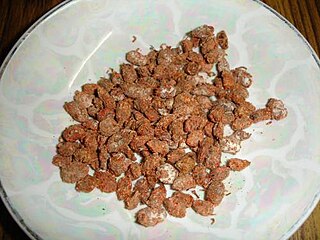
Unani or Yunani medicine is Perso-Arabic traditional medicine as practiced in Muslim culture in South Asia and modern day Central Asia. Unani medicine is pseudoscientific. The Indian Medical Association describes Unani practitioners who claim to practice medicine as quacks.
A medical degree is a professional degree admitted to those who have passed coursework in the fields of medicine and/or surgery from an accredited medical school. Obtaining a degree in medicine allows for the recipient to continue on into specialty training with the end goal of securing a license to practice within their respective jurisdiction. Medical graduates may also pursue non-clinical careers including those in basic research and positions within the healthcare industry. A worldwide study conducted in 2011 indicated on average: 64 university exams, 130 series exams, and 174 assignments are completed over the course of 5.5 years. As a baseline, students need greater than an 85% in prerequisite courses to enrol for the aptitude test in these degree programs.

Alpinia galanga, a plant in the ginger family, bears a rhizome used largely as an herb in Unani medicine and as a spice in Arab cuisine and Southeast Asian cookery. It is one of four plants known as "galangal". Its common names include greater galangal, lengkuas, and blue ginger.
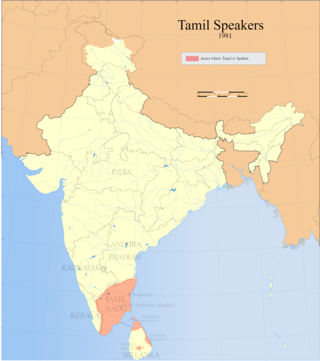
Siddha medicine is a form of traditional medicine originating in southern India. It is one of the oldest systems of medicine in India.
Bachelor of Ayurvedic Medicine and Surgery (B.A.M.S.) is a professional degree focused on Ayurveda offered in India, Nepal, Bangladesh, and Sri Lanka.
The Ministry of Ayush, a ministry of the Government of India, is responsible for developing education, research and propagation of traditional medicine and alternative medicine systems in India. Ayush is a name devised from the names of the alternative healthcare systems covered by the ministry: ayurveda, yoga and naturopathy, Unani, Siddha, Sowa Rigpa, and homeopathy.

Sri Lanka has a free and universal health care system. It scores higher than the regional average in healthcare having a high Life expectancy and a lower maternal and infant death rate than its neighbors. It is known for having one of the world's earliest known healthcare systems and has its own indigenous medicine system.

Wijesinghe Jayaweera Mudiyanselage Lokubandara, was a Sri Lankan politician who was Speaker of the Parliament of Sri Lanka from 2004 to 2010 and Governor of Sabaragamuwa Province from 2010 to 2015. He was a lawyer by profession, and wrote books, poems, and songs. He held several ministries in the government of Sri Lanka before his appointment as Speaker of the House.

Kumaratunga Munidasa was a pioneer Sri Lankan (Sinhalese) linguist, grammarian, commentator, and writer. He founded the Hela Havula movement, which sought to remove Sanskrit influences from the Sinhala language. Considered one of Sri Lanka's most historically significant scholars, he is remembered for his profound knowledge of the Sinhala language and its literary works.
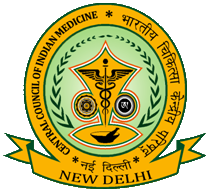
Central Council of Indian Medicine (CCIM) was a statutory body under the Ministry of AYUSH, Government of India between 1971 and 2021. The CCIM was set up in 1971 under the Indian Medicine Central Council Act, which was passed in 1970. It is one of the Professional councils under University Grants Commission (UGC) to monitor higher education in Indian systems of medicine, including Ayurveda, Siddha, Unani and Sowa-Rigpa.
Scientific research in Sri Lanka is carried out by several research institutions. However, historically, Sri Lanka has been behind its regional peers in research funding. Sri Lanka was ranked 89th in the Global Innovation Index in 2024.
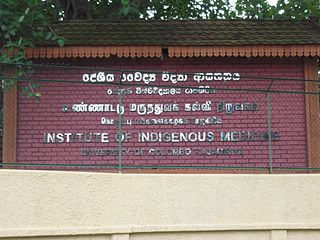
The Faculty of Indigenous Medicine of the University of Colombo, specialising in Ayurveda and the Sri Lankan traditional medicine. Founded as the College of Indigenous Medicine in 1929, it became part of the University of Colombo adopting its current name in 1977. It is a premier center of undergraduate and postgraduate study and research into Ayurveda and Indigenous Medicine and Healthcare.
Amarasinghe Pathiranalage Gunapala Amarasinghe(Sinhala: අමරසිංහ පතිරණලාගේ ගුණපාල අමරසිංහ ) is a Sri Lankan academic. He is a research scientist and a senior lecturer in Ayurvedic paediatrics. He is currently a professor and the head of the Department of Prasutitantra and Kaumarabrithya of Institute of Indigenous Medicine, University of Colombo.
Krishna Chandra Chunekar was an Indian ayurvedic practitioner and writer, known for the books he published, especially the translation of Vedic literature on herbal pharmacopeia. The Government of India awarded him, in 2013, the Padma Shri in medicine, the fourth highest civilian award, for his contributions.
Vaidya Balendu Prakash is an Indian Ayurveda practitioner. He is a former physician to the President of India and the founder of Paadav, a specialty Ayurvedic hospital in Dehradun. The Government of India awarded him the fourth highest civilian award of the Padma Shri in 1999.
Paneenazhikath Narayana Vasudeva Kurup was an Indian Ayurvedic practitioner, researcher, writer and the founder director of the Central Council for Research in Homoeopathy (CCRIMH). He is a former vice chancellor of the Gujarat Ayurved University, Jamnagar and a former advisor of the Indian Systems of Medicine and Homoeopathy (ISM&H) of the Ministry of Health and Family Welfare. He has published several articles and a book, A Handbook on Indian Medicinal Plants, on the traditional Indian medicine system, The Government of India awarded him the fourth highest civilian honour of the Padma Shri, in 2005, for his contributions to Indian medicine.

The Gampaha Wickramarachchi University of Indigenous Medicine, is a public university located in Yakkala, Sri Lanka. It was established by Ayurveda Cakrawarti Pandit G.P. Wickramarachchi in 1928 as the Gampaha Sidayurveda Vidyalaya and in 1982 it was incorporated as Gampaha Wickramarachchi Ayurveda Vidyalaya under the Ministry of Indigenous Medicine.
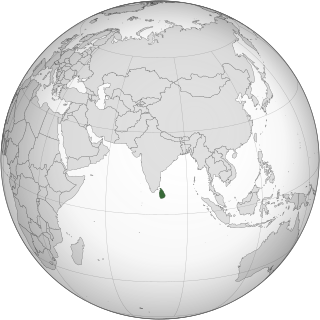
Cannabis in Sri Lanka is legally sold through Ayurveda herbal shops, and can be used for medical and scientific purposes if given a license by the Ministry of Health. For recreational usage cannabis is not legal. However, cannabis plays a major role in the traditional culture of the island, with the specific Sinhalese or Sanskrit names virapati (“hero-leaved”), capta (“light-hearted”), ananda (“bliss”), trilok kamaya and harshini indicating its various properties, such as inducing euphoria and heightening sexual energy.












